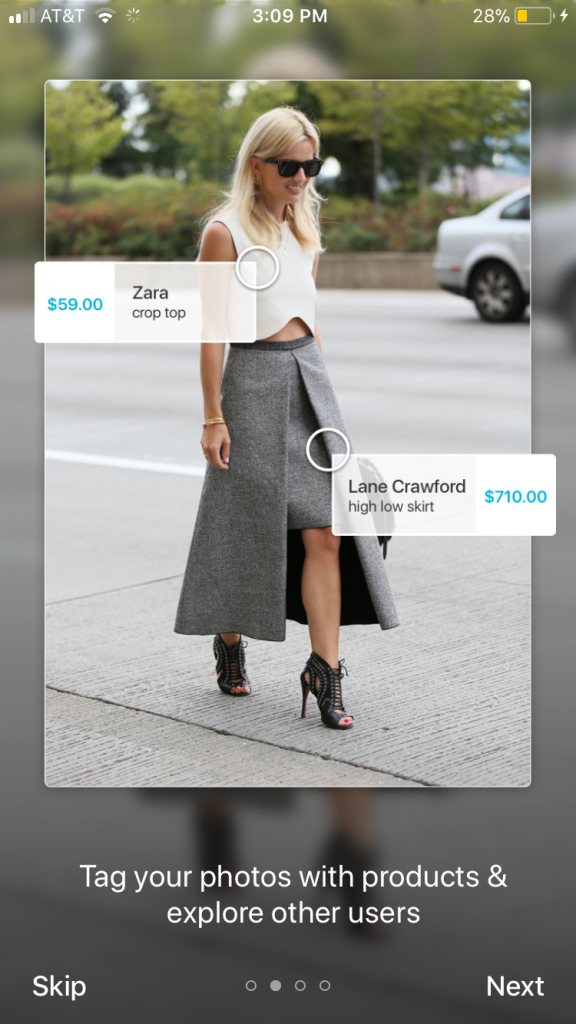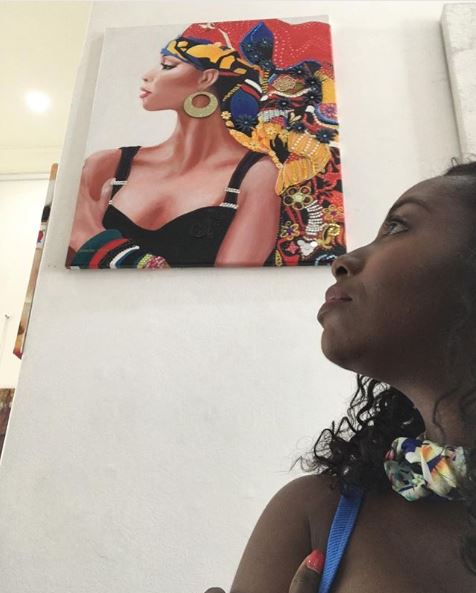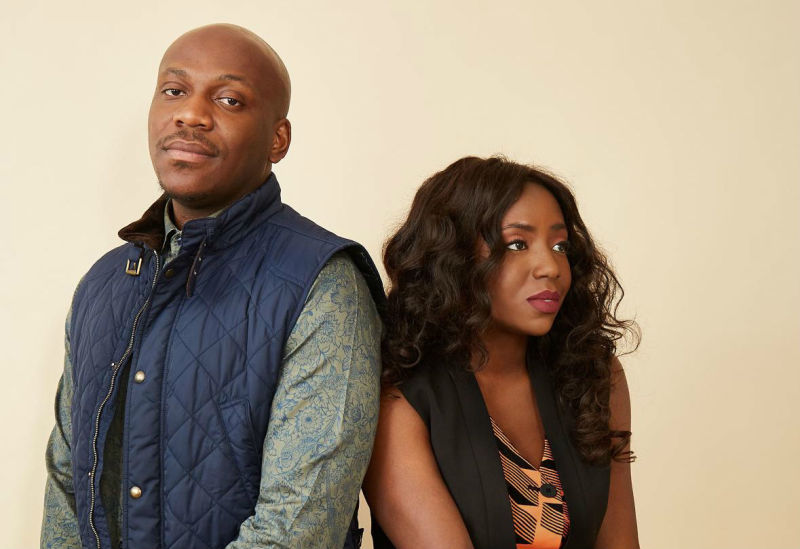How a pink jacket – and elusive red shoes – inspired COSIGN, which pays you to post selfies
Across the crowded train, he saw her. What grabbed Abiodun Johnson’s eye and his imagination was her bold look. Emerald green sweater dress. Velvet brown blazer. Tall leather boots. And a loud, pink puffer coat. He was impressed and intrigued.
They exited at the same subway stop. On the steps up to the Manhattan sidewalk, Johnson gently tapped Esosa Ighodaro on the shoulder of that pink jacket. She turned.
“I love your outfit!” he said with a smile.
“Oh, thank you!” Ighodaro responded, amused. “You must be from out of town because New Yorkers don’t talk to each other. At least, not on the subway.”
But they kept talking, well past that random meeting five-plus years ago. And soon, they spotted a market need: connecting one person’s stylish choice to another person’s desire to find it, buy it and wear it.

Today, Ighodaro, a 31-year-old Brooklyn native, and Johnson, 32, and raised in Tennessee, are the co-founders of COSIGN, the first app that pays users to post selfies and share their fashion sense on social networks – turning their photos into interactive, viral storefronts.
“Now anyone can essentially recommend a product through their images, an image they are going to post anyway,” Ighodaro says.
“With COSIGN, you no longer have to ask your friend: ‘Oh, where did you get this from?’ You just click and you buy.”
Several thousand people have downloaded the free app to their Android or iOS phones via Google Play or the iTunes App Store. Users snap photos showing a favorite garment, beloved getup or products such as lipstick, jewelry, handbags or hair conditioner.
They post their selfies to Facebook, Twitter, Instagram, Pinterest or Tumblr, tagging the product type, price and brand name.
When anyone clicks on the post to buy that item, corresponding online retailers pay COSIGN a share of the sales revenue and COSIGN, in turn, pays the user 30 to 60 percent of that commission.
The app runs through Microsoft Azure. The co-founders next plan to leverage the Microsoft AI platform, including Machine Learning Studio, to enhance COSIGN’s capabilities.

“We are democratizing the opportunity to earn,” Ighodaro says. “People who are always great at recommending cool things usually don’t get paid for that content. They are constantly cut out of the transaction. But they are really the genesis of why you’ve discovered a product.
“If you tell somebody of a new product that they didn’t know about, and if they take the impetus and go buy it, you deserve some of that share,” she adds. “Brands do this at a larger scale with celebrities, right? But you’re a local celebrity!”
COSIGN is part of a burgeoning, “social commerce” evolution.
Popular with millennials, social commerce offers the ability to buy products from a third-party company via social media – or, more specifically, through friend recommendations, reports the Huffington Post.
At the heart of that phenomenon is another social media reality: FOMO, fear of missing out. You spot a funky hat or a pair of sharp kicks in a posted pic or video and that item must be yours. Now. But where to find it?
Both co-founders had experienced those kinds of relentless consumer pursuits – quests that ultimately helped inspire the launch of COSIGN in 2015.
Johnson, for example, was captivated by one scene in a recent Nissan commercial on YouTube. The ad featured a daredevil character hurdling a table in slow motion while wearing hip red shoes
“I was trying to find those shoes. I did what people typically do – go to Google and try to search for them. I didn’t find the product,” Johnson says. “But I found other people looking for those same red shoes.
“Obviously, there’s a disconnect here in terms of seeing products in the wild and being able to purchase them instantaneously. That was the whole genesis of the idea,” he says.
Beyond guiding those purchases, COSIGN added fruitful flipside to the equation: compensating people for unearthing fashion gems and displaying them on social channels. That key function attracted, among others, Diana Melencio, a 30-something, luxury retail professional in New York City.
“I tell people that if they already enjoy sharing their style on social, and tagging brands, why not use COSIGN to make it easy to get paid for it?” Melencio says.
Melencio, who describes her style as “modern, clean and fashion forward,” typically uses the app while on vacations or during other travels. Through COSIGN, she has posted images of more than 50 products – apparel, shoes and accessories – to her 2,000-plus followers on Facebook, Instagram and Twitter.
While attending a recent New York Fashion Week show, Melencio wore a lavender Rebecca Minkoff jumpsuit and a colorful Desigual clutch that she’d received as a gift for visiting the show. She stopped at the Tresemme hair salon to take a selfie then uploaded it to Facebook and Instagram, tagging the brands via COSIGN.
Via that photo, one of Melencio’s friends purchased one clutch for herself and another as a gift. Melencio received about $20 for that post. Altogether, she’s earned about $100 from the app, she says.
“I’ve always been the friend that everyone comes to for fashion advice,” she says. “Using COSIGN was a no brainer.”
Twenty retailers, including Nordstrom, Bloomingdale’s and Sephora, partner with COSIGN through an affiliate model. The company intends to add more brands and new verticals, including consumer electronics and interior design.

As the app gains users, the business is pivoting into a platform solution, Johnson says. It now offers a publisher tool and the ability for brands to white label COSIGN’s platform or to leverage parts of COSIGN’s technology through APIs.
A tight core of people operates the New York City-based startup. In addition to the co-founders, COSIGN employs a chief science officer and a chief technology officer as well as part-time staff that handle development, legal and marketing.
They all know the story of Johnson’s long chase for those red shoes. But Ighodaro has gone on her own retail hunting missions. Before COSIGN, when mystery products caught her eye in social photos, she often showed the images to store clerks and asked, “Hey, do you have this?”
“If stores didn’t have them, I would go to the blog sites or call the show room,” she says. “Yeah, my shopping addiction was a little bit more than A.J.’s, I would say. Some people, they see something, they do a Google search, and that’s it. Not this person.
“But there are just so many barriers between getting the product information and actually buying it. You want that see-now-buy-now experience. We finally decided that’s a big enough problem to solve,” Ighodaro says.
The red shoes?
They remain elusive. Johnson and Ighodaro only have an unconfirmed hunch about the brand.
But in a way, those shoes still fuel their entrepreneurial hunger to see that all social media hounds finally get the ability to see a product in the wild, then click it and capture it.
Top image: Abiodun Johnson, left, Esosa Ighodaro, right. All images courtesy of COSIGN.








